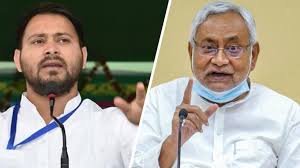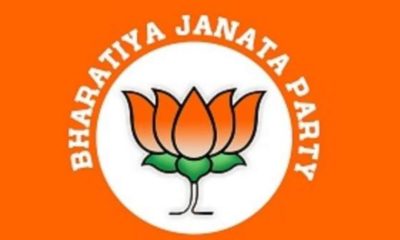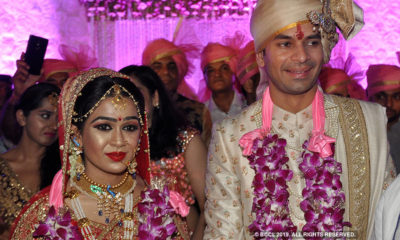Feature
Lalu protests withholding of caste census data

Patna: Rashtriya Janata Dal (RJD) chief Lalu Prasad led thousands of his party workers here on Monday to protest the withholding of the caste-based census data by the Centre and demanded it be made public.
Lalu Prasad along with his two sons — Tej Pratap and Tejasvi Yadav — sitting in an open jeep led the protest march to Raj Bhawan here.
Addressing his party workers and supporters ahead of hitting the road, the former Bihar chief minister asked the people belonging to “Mandal (the backward classes) to rise and uproot the Kamandal (the anti-backward class BJP)”.
He said such a step was required because “the Bharatiya Janata Party (BJP)-led central government is anti-poor, anti-backward class and anti-Dalits”.
He appealed to all Dalits, OBCs (other backward classes) and Muslims to unite against Prime Minister Narendra Modi’s government.
“This march is just a beginning. We would protest (right up to) to parliament because Modi is not eager to make the data public soon. We will also stage dharna and protest in each village to block headquarters and district headquarters,” he said.
The RJD chief threatened to launch a bigger movement than the Mandal movement of the 1990s if the Modi government failed to make the caste-based census data public without any further delay.
Lalu Prasad said the RJD would call for Bihar bandh (shutdown) soon and if required the party would initiate ‘jail bharo andolan’ (courting arrests).
“RJD would compel the BJP-led central government to make public the caste-based Census data soon…,” he told party workers before they launched the march.
Stating that the people of the country have a right to know the details of caste-based Census, he said: “Centre should make the caste census public instead of withholding the data on numerical strength of different castes.”
Lalu Prasad said people, particularly the poorest of the poor, marginalised and downtrodden sections of the society, deserved to know it and every caste should know its strength and weakness in terms of population and other aspects.
He said the RJD’s allies – the Janata Dal-United (JD-U), Congress and National Congress Party (NCP) – have extended moral support to it on the issue.
Lalu Prasad hinted that the issue could be one of the main planks of the alliance of the RJD, JD-U, Congress and the NCP in the upcoming Bihar assembly polls.
Entertainment
Meghalaya Reserves Legalized Gambling and Sports Betting for Tourists

The State Scores Extra High on Gaming-Friendly Industry Index
Meghalaya scored 92.85 out of 100 possible points in a Gaming Industry Index and proved to be India’s most gaming-friendly state following its recent profound legislation changes over the field allowing land-based and online gaming, including games of chance, under a licensing regime.
The index by the UK India Business Council (UKIBC) uses a scale of 0 to 100 to measure the level of legalisation on gambling and betting achieved by a state based on the scores over a set of seven different games – lottery, horse racing, betting on sports, poker, rummy, casino and fantasy sports
Starting from February last year, Meghalaya became the third state in India’s northeast to legalise gambling and betting after Sikkim and Nagaland. After consultations with the UKIBC, the state proceeded with the adoption of the Meghalaya Regulation of Gaming Act, 2021 and the nullification of the Meghalaya Prevention of Gambling Act, 1970. Subsequently in December, the Meghalaya Regulation of Gaming Rules, 2021 were notified and came into force.
All for the Tourists
The move to legalise and license various forms of offline and online betting and gambling in Meghalaya is aimed at boosting tourism and creating jobs, and altogether raising taxation revenues for the northeastern state. At the same time, the opportunities to bet and gamble legally will be reserved only for tourists and visitors.
“We came out with a Gaming Act and subsequently framed the Regulation of Gaming Rules, 2021. The government will accordingly issue licenses to operate games of skill and chance, both online and offline,” said James P. K. Sangma, Meghalaya State Law and Taxation Minister speaking in the capital city of Shillong. “But the legalized gambling and gaming will only be for tourists and not residents of Meghalaya,” he continued.
To be allowed to play, tourists and people visiting the state for work or business purposes will have to prove their non-resident status by presenting appropriate documents, in a process similar to a bank KYC (Know Your Customer) procedure.
Meghalaya Reaches Out to a Vast Market
With 140 millions of people in India estimated to bet regularly on sports, and a total of 370 million desi bettors around prominent sporting events, as per data from one of the latest reports by Esse N Videri, Meghalaya is set to reach out and take a piece of a vast market.
Estimates on the financial value of India’s sports betting market, combined across all types of offline channels and online sports and cricket predictions and betting platforms, speak about amounts between $130 and $150 billion (roughly between ₹9.7 and ₹11.5 lakh crore).
Andhra Pradesh, Telangana and Delhi are shown to deliver the highest number of bettors and Meghalaya can count on substantial tourists flow from their betting circles. The sports betting communities of Karnataka, Maharashtra, Uttar Pradesh and Haryana are also not to be underestimated.
Among the sports, cricket is most popular, registering 68 percent of the total bet count analyzed by Esse N Videri. Football takes second position with 11 percent of the bets, followed by betting on FIFA at 7 percent and on eCricket at 5 percent. The last position in the Top 5 of popular sports for betting in India is taken by tennis with 3 percent of the bet count.
Local Citizens will Still have Their Teer Betting
Meghalaya residents will still be permitted to participate in teer betting over arrow-shooting results. Teer is a traditional method of gambling, somewhat similar to a lottery draw, and held under the rules of the Meghalaya Regulation of the Game of Arrow Shooting and the Sale of Teer Tickets Act, 2018.
Teer includes bettors wagering on the number of arrows that reach the target which is placed about 50 meters away from a team of 20 archers positioned in a semicircle.
The archers shoot volleys of arrows at the target for ten minutes, and players place their bets choosing a number between 0 and 99 trying to guess the last two digits of the number of arrows that successfully pierce the target.
If, for example, the number of hits is 256, anyone who has bet on 56 wins an amount eight times bigger than their wager.





















